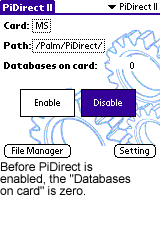
PiDirect II
PiDirect II provides Palm OS with a virtual
memory capability. It handles a selected directory on a memory card such that the OS sees the directory's content
as being in RAM. This permits non-VFS aware apps to access their read-only databases on a memory card, freeing
up precious RAM. It also makes applications in its directory appear as if in RAM.
First, some technical illumination. Virtual memory on your PC is disk space from which the operating system (OS)
swaps inactive data in and out of RAM to keep RAM available for active applications or threads. The same principle
applies to PDA relative to memory cards, except that data is only read from the card but not written back. This
approach provides a couple of advantages over putting some, but not most, apps in /Palm/Launcher/. Virtual memory
is loaded on a demand basis. In other words, only the parts needed at the moment are copied from the card into
RAM. Since the entire database or application isn't copied all at one, access to the pertinent data is faster
than loading the whole file--much faster for large databases. So, the apps that benefit from this approach are
those that can be loaded in segments (very few Palm OS apps) or apps that have their large databases in the .prc
file itself.
The limitation of PDA virtual memory is that it is read-only. Unlike on the PC, data is swapped off but not back
on the card. In fact, attempting to alter a file under PiDirect's watchful eye will fail and perhaps cause a fatal
exception. So, you don't want to run databases under PiDirect that will be changed by their parent application.
But, there are plenty of databases that fit the criteria. For example, the large star and Messier databases under
Star Pilot Advanced along with some of its ancilliary apps, Noah Lite's dictionary databases, WordSmith's spell
check and thesaurus databases along with its FineType fonts, Clie RMC's definition files, Big Clock's 16-bit color
backgrounds, RichReader's fonts, VoxClock's sound database, CSpotRun's hyphenation database, and a host of reference
docs fit this mold perfectly.

PiDirect installs as both an application and as a preference panel, providing the same functionality from both
locations. The opening screen is very simple, allowing the user to enable or disable PiDirect, as well as listing
the number of files managed by PiDirect. PiTech recommends a maximum of 50 files under PiDirect, but I've run
up to 77 files with no problem. YMMV. The opening screen also lists the directory managaed by PiDirect. With
PiDirect disabled, two more screen buttons present themselves: File Manager and Setting.
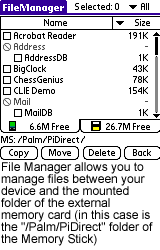
The file manager exists for one purpose, to copy/move files between RAM and the PiDirect folder. Like MS Gate,
PiDirect sorts files by their parent application, listing supporting databases together with their apps. PiDirect
supports multiple file operations. Tap Back to return to the primary screen.
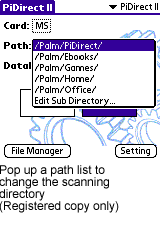
Tapping on the Path permits selection of the directory you want PiDirect to manage. Although PiDirect will only
manage one folder at a time, having multiple paths to select allows the user to change configurations depending
on what data they need at the moment. You can also add paths from this display.
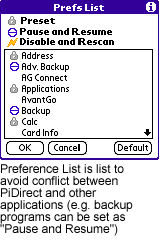
The settings button leads to a critical screen that resembles a file manager. This screen allows the behavior
of PiDirect towards individual apps. Some apps, like MS Import and Backup work best when PiDirect is Paused and
Resumed. Others, like File Managers, work best when PiDirect is Disabled and Rescans. Standard Palm OS apps have
presets. When executing an app causes problems, this is one place to seek a solution.
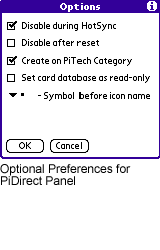
Preferences are set under Menu/Options/Preferences. A number of safety tips apply here. First, uncheck the "Set
card database as read-only" box before attempting to run PiDirect for the first time. Selecting this box
causes the majority of problems folks encounter. I recommend selecting "Disable during HotSync". This
prevents a host of problems as well. "Disable after reset" can be helpful if you find yourself in an
endless reset loop due to an app under PiDirect's control. PiDirect can have a symbol appear in from of apps in
the built-in launcher that are under its management. The benefit is that this reduces your chances of trying to
delete those apps while PiDirect is active, which would cause a fatal exception.
PiDirect II 2.0 works as advertised. I've used it for over a year, and found it to be both stable and reliable.
I'm currently running 63 databases under PiDirect, saving 10.6 MB of space in RAM. After upgrading to PiDirect
II 2.2, I found a glaring problem between it and SwitchDash 0.44. After much frustration being ignored by PiTech,
I finally reverted to version 2.0 and have stayed with it.
PiDirect II is commercial, selling for $29.95. That seems steep, especially since MS Mount does essentially the
same thing for free. However, PiDirect has proven more stable than MS Mount, though some have no problems with
either. PiDirect is certainly more configurable. Personally, I wouldn't leave home without it.